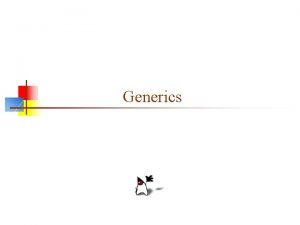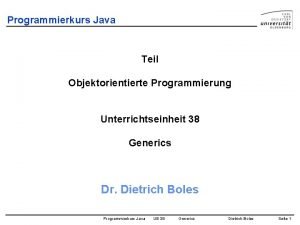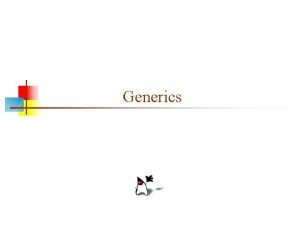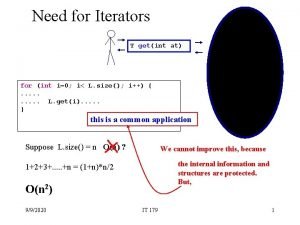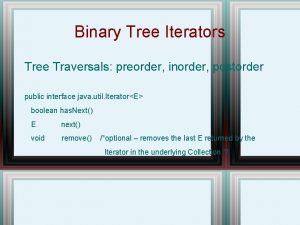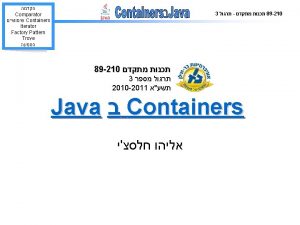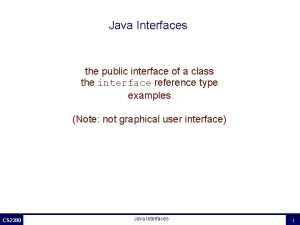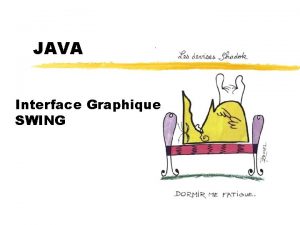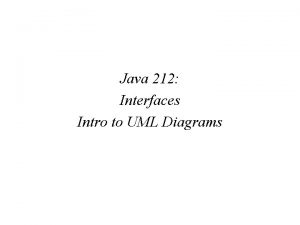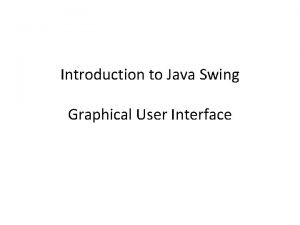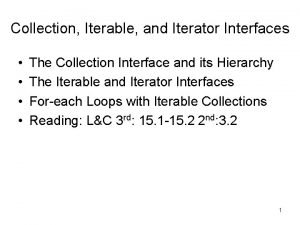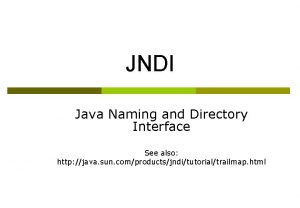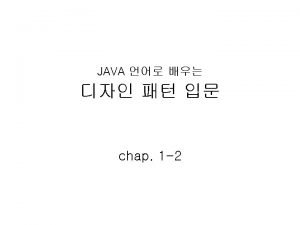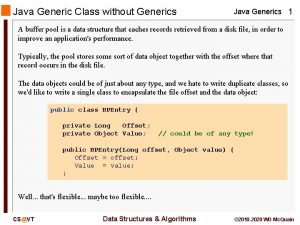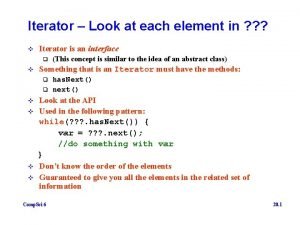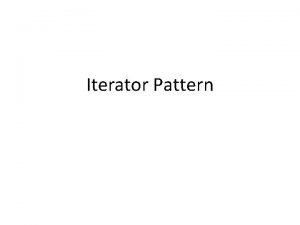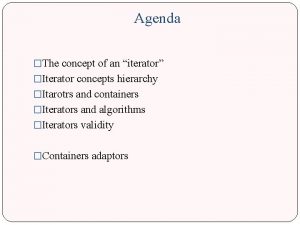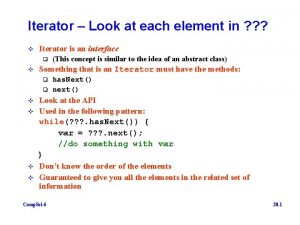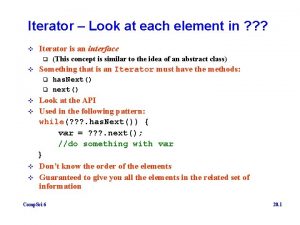Java Review Interface Casting Generics Iterator Interface A




























- Slides: 28

Java Review Interface, Casting, Generics, Iterator

Interface • A group of empty methods – design blueprint Public interface Stack { public Object pop(); public void push(); public int size(); } • Implementing Interface Public class Array. Stack implements Stack { … … }

Use Interface as Type • You can use interface names anywhere you can use any other data type name. Stack a. Stack; • If you define a reference variable whose type is an interface, any object you assign to it must be an instance of a class that implements the interface. a. Stack = new Array. Stack();

Java Multiple Inheritance through interface Can you do this? Public class my. C extends my. A, my. B { … } Can you do this? Public interface C extends A, B { … } Can you do this? Public class my. CD implements C, D { … }

Java Multiple Inheritance through interface Can you do this now? my. CD obj 1 = new My. CD(); C obj 2 = new My. CD(); D obj 3 = new My. CD(); A obj 4 = new My. CD(); B obj 5 = new My. CD(); What are the real differences for the above obj 1, obj 2, obj 3, obj 4, obj 5? • They are references to five different objects of class type my. CD. • They can only access the member/methods for the class type they were defined as. • Casting can be applied to them

Reference and primitive data � Variable of primitive type int x , y; x = 5; y = x; //copy x to y x = 4; What is value of x, y? � Variable of reference my. Obj obj 1, obj 2; Obj 1 = new my. Obj(); Obj 1. x = 5; obj 2 = obj 1; //? ? ? copy obj 1 to obj 2? ? ? Obj 2. x = 4 What is value of obj 1. x? � How to copy an object? � How to compare two objects to see if they have same information? � Can you do obj 1==obj 2?

Casting – Type conversion • Widening conversion –Cast a class type to its super class type –Cast a interface type to its super interface type –Cast a class type to the interface type it is implementing • Example Object obj; obj = new Mountain. Bike(); Stack a. Stack; a. Stack = new Array. Stack();

Casting – Type Conversion • Narrowing conversion – Require explicit cast –Opposite of widening conversion • Cast a superclass type object to subclass type • Cast a superinterface type to subinterface type • Cast a interface type to the class type who implemented the interface • Example Object obj; Mountain. Bike my. Bike; … my. Bike = (Mountain. Bike)obj;

Casting exception • Cast an object reference o of type T to type S –If o is indeed referencing an object of type S, fine. –Otherwise, exception “Class. Cast. Exception” will be thrown • Use try-catch • Use instance. Of to test –Object_reference instanceof reference_type if (obj instanceof Mountain. Bike) { Mountain. Bike my. Bike = (Mountain. Bike)obj; }

What is the output of Demo? Public Class Fruit { public void get. Name() { System. out. println(“My name is fruit”); } } Public Class Apple extends Fruit{ public void get. Name() { System. out. println(“My name is Apple”); } } Public class Demo { Public static main(…) { Fruit fruit= new Apple(); fruit. get. Name(); }

Dynamic binding • Static type • the declared type of a variable • Dynamic type • The most child-like type of the variable at run-time • Static binding happens at compiler time • Dynamic Binding happens at run time • overridden methods are bonded using dynamic binding

The need for Generics �Many data structures and algorithms operate on variety of data type �For example: Stack, Queue �Java Generic feature captures this idea �allows us to specify formal type parameters. �Can we use Object instead of formalized type parameter? Yes, but with generic �Eliminate many casting �Avoid run time type conversion error � Compile time type checking �Code is easy read

Formal type with the class definition • A generic type is a type that is not defined at compilation time – formal type parameters Public class Pair<K, V> { K key; V value; public void set(K k, V v) { key = k; value = v; } }

The formal type defined for a method • How to define formal types which are used only in a method, not the scope of the class? –writing a method that takes an array of objects and a collection and puts all objects in the array into the collection static <T> void from. Array. To. Collection(T[] a, Collection<T> c) { for (T o : a) { c. add(o); } }

Bounded Generic type �How to limit the formal type? Public class Directory<P extends Person>

Generics - instantiation • How to instantiate an object of the class that is defined with formal type? Pair<String, Integer> pair 1 = new Pair<String, Integer>(); pair 1. set(new String(“height”), new Integer(36)); Pair<Student, Double> pair 2= new Pair<Student, Double>(); Pair 2. set(new Student(“A 5976”, ”Sue”, 19), new Double(9. 5));

Generic interacts poorly with arrays � 3 bad interactions that you are likely to encounter 1. Basic generic array 2. Array of parameterized type 3. Array of inner classes inside parameterized types

1. Basic generic array • How to create an array of type E where E is a formal type? Class Foo<E> { void m() { E[] local. Arr; //declare a reference - this is fine. //local. Arr = new E[100]; //allocate an array. Doesn’t work! local. Arr = (E[]) new Object[100]; //work around #1 } } Work around: create an array of object and then explicitly cast to type array E. Yes, working around #1 will generate a warning. Just accept it.

2. Array of a parameterized type • Java allows an array to be defined with a parameterized type Pair<String, Integer>[] a; • But it does not allow a parameterized type to be used to create a new array a = new Pair<String, Integer>[10]; // Doesn’t work! • But you can initialize with a nonparametric array (raw type), and cast it a = (Pair<String, Integer>[]) new Pair[10]; // workaround #2

3. Array of inner classes inside parameterized types Class C<E> { class D { // inner class … } // Doesn’t work! Annoying! D is a real class. Why? //D[] array = new D[100]; D[] array = (D[]) new C. D[100]; // Workaround #3 } } Class D does not have generic parameters, why not working? Because class D is actually C<E>. D, and D[] array = new D[100] is actually C<E>. D[] array = new C<E>. D[100] It is indeed the very similar to the workaround #2

Don’t shadow type parameters in inner classes Class C<E> { class D<E> { // inner class … } } Class C<E> { E x; class D<E> { // inner class E y = x; // compile error - not the same type! } } Class C<E> { E x; class D { // inner class E y = x; // this works fine. } }

Traverse the items • It is a common task to cycle through a collection of objects in a data structure. • Each data structure has it’s own natural way to loop through all the elements. array – start from the first cell, loop by index linked list – start from the head, follow pre/next pointer tree – start from the root, recursive call the children pointers

Iterators �An iterator is a software design pattern that abstracts the process of scanning through a sequence of elements, one element at a time. Lists and Iterators © 2014 Goodrich, Tamassia, Goldwasser

The Iterable Interface � Java defines a parameterized interface, named Iterable, that includes the following single method: �iterator( ): Returns an iterator of the elements in the collection. � An instance of a typical collection class in Java, such as an Array. List, is iterable (but not itself an iterator); it produces an iterator for its collection as the return value of the iterator( ) method. � Each call to iterator( ) returns a new iterator instance, thereby allowing multiple (even simultaneous) traversals of a collection. Lists and Iterators © 2014 Goodrich, Tamassia, Goldwasser

The for-each Loop �Java’s Iterable class also plays a fundamental role in support of the “for-each” loop syntax: is equivalent to: Lists and Iterators © 2014 Goodrich, Tamassia, Goldwasser

Summary: How to use iterator 1. Obtain an iterator by calling the collection's iterator( ) method 2. Have the loop iterate as long as has. Next( ) returns true. 3. Within the loop, obtain each element by calling next( ). Note: For the data structures that we will be implementing this semester, you need to implement the iterator() for them.

Iterator example – while loop import java. util. *; public final class Loop. Styles { public static void main( String. . . a. Arguments ) { List<String> flavours = new Array. List<String>(); flavours. add("chocolate"); flavours. add("strawberry"); flavours. add("vanilla"); use. While. Loop( flavours ); use. For. Loop( flavours ); } private static void use. While. Loop( Collection<String> a. Flavours ) { Iterator<String> flavours. Iter = a. Flavours. iterator(); while ( flavours. Iter. has. Next() ){ System. out. println( flavours. Iter. next() ); } }

Iterator example – for loop // Use for - each loop. More easy to make iteration over arrays or other collections private static void use. For. Loop( Collection<String> a. Flavours ) { for ( String flavour : a. Flavours ) { System. out. println( flavour ); } } }
 Generic array in java
Generic array in java Generics java erklärung
Generics java erklärung Benefits of generics in java
Benefits of generics in java Java generics array
Java generics array Iterator inner class java
Iterator inner class java Iterator vs iterable java
Iterator vs iterable java Interface in interface java
Interface in interface java Using system.collections.generic
Using system.collections.generic Hospitality generics
Hospitality generics Kotlinx serialization optional
Kotlinx serialization optional C generics
C generics Iterator pattern python
Iterator pattern python Inorder iterator
Inorder iterator Rapidjson iterator
Rapidjson iterator Iterator entwurfsmuster
Iterator entwurfsmuster Comparator design pattern
Comparator design pattern Volcano iterator model
Volcano iterator model Zig iterator
Zig iterator Code blocks in python
Code blocks in python User led through interaction via series of questions
User led through interaction via series of questions Office interface vs industrial interface
Office interface vs industrial interface Interface------------ an interface *
Interface------------ an interface * Java extend interface
Java extend interface Public interface java
Public interface java Interface graphique java
Interface graphique java Java interface uml
Java interface uml Java graphical user interface
Java graphical user interface Collections iterable
Collections iterable Java naming directory interface
Java naming directory interface
